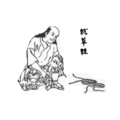Waraji

Waraji (草鞋) are sandals made from straw rope that in the past were the standard footwear of the common people in Japan.
Use
Waraji are basically a form of zōri, so they are worn very similarly. The main difference (in wear) between zōri and waraji is that one's toes traditionally protrude slightly over the edge of the waraji. This does not happen with zōri. The other difference is that one normally doesn't wear tabi with waraji, as opposed to zōri.
Nowadays, it is mainly Buddhist monks who wear waraji. Most Japanese wear zōri or geta.
Tying
Everyone tied their waraji differently from one another. There was no standard way to tie waraji.
Gallery
-
Waraji hanging on a building
-
Waraji facing left.
-
Samurai putting on waraji.
See also
References
Wikimedia Commons has media related to Waraji.




